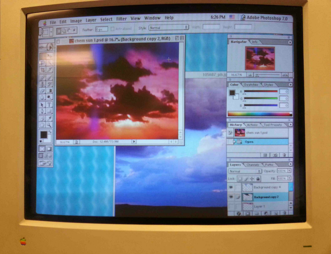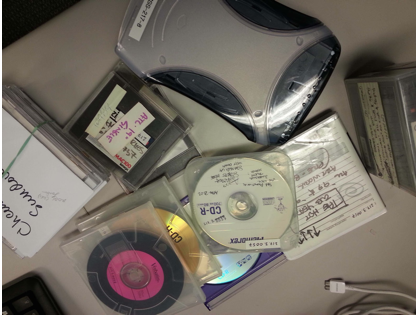Julia here. In my last post, I gave an overview of the digital forensics AMIA panel I chaired. In this post, I’ll go over some of the work I’m doing as a resident at New York University Libraries, with a special focus on the Jeremy Blake Papers. My current task is to create access-driven workflows for the handling of complex, born-digital media archives. My work, then, does not stop at ingest but must account for researcher access. I’m processing 20 collections, each with its own set of factors that influence the direction workflows may take. For example, collections can range in size from 30 MB on 2 floppy disks to multiple terabytes from an institution’s RAID. Collection content may comprise simple .txt and ubiquitous .doc files or, as is the case of material collected from computer hard drives, may hold hundreds of unique and proprietary file types. Further complicating the task of workflow creation, collections of born-digital media often present thorny privacy and intellectual property issues, especially with regard to identity-specific (ex: social security) information which is generally considered off-limits in areas of public access.
At this point in the fellowship, I have conducted preliminary surveys of several small collections with relatively simple image, text, moving image, and sound file formats. Through focusing on accessibility with these smaller collections first, I’ll develop a workflow that encompasses disparate collection characteristics. These initial efforts will help me to formulate a workflow as I approach two large, incredibly complex collections: the Jeremy Blake Papers and the Exit Art Collection. I’ll spend the rest of this post discussing the Blake Papers.
Jeremy Blake (1971-2007) was an American digital artist best known for his “time-based paintings” and his innovations in new media. The Winchester trilogy exemplifies his methodology, which transversed myriad artistic practices: here, he combined 8mm film, vector graphics, and hand-painted imagery to create distinctive color-drenched, even hallucinatory, atmospheric works. Blake cemented his reputation as a gifted artist with his early artistic and commercial successes, such as his consecutive Whitney Biennial entries (2000–2004, inclusive) and his animated sequences in P.T. Anderson’s Punch Drunk Love (2002).
The Jeremy Blake Papers include over 340 pieces of legacy media physical formats that span optical media, short-lived Zip and Jaz disks, digital linear tape cartridges, and multiple duplicative hard drives. Much of what we recovered seemed to be a carefully kept personal working archive of drafts, digitized and digital source images, and various backups in multiple formats, both for himself and for exhibition. While the content was often bundled into stacks by artwork title (as exhibited), knowing that multiple individuals had already combed through the archive before and after acquisition of the material make any certainty as to provenance and dating impossible for now. In addition to work files, we are also processing emails and other assorted files recovered from his laptop.
Through the work I’ll be doing over the course of this fellowship (stay tuned), researchers will be able to explore Blake’s work process, the software tools he used, and the different digital drafts of moving image productions like Chemical Sundown (2011).
Processing the Jeremy Blake Papers will necessitate exploration of the problems inherent in the treatment of digital materials. Are emails, with their ease of transmission and seeming immateriality, actually analogous to the paper-based drafts and correspondences in the types of archives we have been processing for years? Or are we newly faced with the transition to a medium that requires seriously rethinking our understandings and retooling of our policy procedures to protect privacy and prevent future vulnerability? While we haven’t explicitly addressed the issue yet, these are some of the bigger questions that our field will need to explore as we balance our obligations to donors as well as future researchers. Tangential, but not irrelevant, are the types of questions surrounding the belated conception, positioning, and exhibition of post-mortem presentations of incomplete works, such as Blake’s unfinished Glitterbest). These are some of the serious conundrums I am addressing in my work as I draft the clauses addressing born-digital materials for our donor agreement templates—creating concrete policy formations which will be implemented during the course of an acquisition and donor interview next week.
The Blake collection was initially reported to include over 125,000 files. We have recently had to renumber and rethink the accuracy of some of the initial figures, thanks in no small part to the discovery of hitherto occluded media in unprocessed boxes. Initially, my mentor, New York University Digital Archivist Don Mennerich, and I were working with files copied (and therefore significantly altered) from Blake’s hard drives received in 2010 2009, before write-blocker hardware was part of the required protocol for handling digital material at NYU. Taking clues from the fields of legal and criminal investigation, adoption of relevant digital forensics practice in cultural heritage institutions didn’t happen until after breakthroughs such as the publication of CLIR born-digital forensic (2010) paper. Not having the file timestamps severely limited our ability to assess the collection’s historical timespan. In our predictions with regard to research interest, charting Blake’s work progress over time would have been high up on the list, so this bar chart (created from Access Data’s FTK software) was obviously not ideal. Digital files are delicate; the ways in which file access information is recorded lends itself to distortion.

Visualization of 1st set of Blake born-digital material with all dates modified. The grey rectangle represents the modified access date. That is, all the files show the same date rather than a span of years.

Visualization of 2nd set of Blake born-digital material with intact date span, as
represented by the many gray lines across almost a decade.
Luckily, the issues created by previous access to archival files were resolved after some digging into written reports regarding the collection, along with the important discovery of four boxes of unprocessed material. Enlisting the aid of a number of student interns, we’ve imaged (created bit exact replicas, which can itself be a difficult hurdle ) more than half of these materials. Comparing newly imaged material with the initial Blake acquisition files, we have determined that many of the acquired, compromised files are duplicative, and consequently we have been able to assign the correct time-date stamps! That is, many of the files from the 2nd set of born-digital media images were in the 1st set as well. Blake clearly understood the importance of redundancy in his own workflow. I’ve no doubt that this is (or may prove to be) a common experience for archivists processing digital materials.
At this point, Blake’s collections have been previewed, preliminarily processed, and arranged through Access Data’s FTK software. This is a powerful but expensive software program that can make an archivist’s task-—to dynamically sift through vast quantities of digital materials—even plausible as a 9-month project. While Don and I manage the imaging and processing, we’ve also starting discussing what access types might look like. This necessitates discussions with representatives from all three of NYU’s archival bodies (Fales, University Archives, and Tamiment), as well as the head of its new (trans-archive) processing department, the Archival Collections Management Department. In our inaugural meeting last week, we discussed making a very small (30 MB) collection accessible to researchers in the very near future as a test case for providing access to some of our larger collections. As part of my responsibilities here, I’ll be chairing this group as we devise access strategies to collection content.
More specifically, we have also set up hardware and software formulations that may help us to understand Blake’s artistic output. In the past two weeks, for example, Don has identified the various Adobe Photoshop versions that Blake used through viewing the files through the hex (hexadecimal of the binary). We have sought out those obsolete versions of Adobe Photoshop, and my office area is now crowded with different computers configured to read materials from software versions common to Blake’s most active years of artistic production. Redundancy isn’t just conducive to preventing data loss, however. We still need multiple methods with which to view and assess Blake’s working files. In addition to using multiple operating systems, write-blockers, imaging techniques, and programs, I spent several days installing emulators on our contemporary Mac, PC, and Unix machines. After imaging material, we’ll start systematically accessing outdated Photoshop files via these older environments, both emulated and actual.

Hex editor view used to help identify software versions used (extra points if you recognize what Blake piece this file is from).
In the meantime, I still need to make a number of decisions and the workflow is still very much a work in progress! This underpins a larger point: This fellowship necessitates documentation to address gaps like these. That is, while there are concrete deliverables for each phase of the project, in order to deliver I’ll need to understand and investigate intricacies in the overall digital preservation strategy here at NYU. While working with very special collections like the Jeremy Blake Papers is a great opportunity, it’s also great that the questions we address will be useful at our host sites for many other projects down the line. While I may not be able to write more on Blake in the blog, Don Mennerich and I will co-present our paper documenting our findings at the American Institute of Conservation (AIC) this May…but in the meantime, lot’s of work will need to get done!


